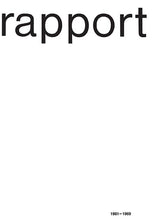I 2013 genudgav forlaget *[asterisk] bogen århus rapport 1961-69 i forbindelse med udstillingen LÆSEMASKINER – udfoldning af bøger og arkiver (Kunsthal Aarhus, 2013), som del af et større arkiv projekt i udstillingen og som supplement til en kommende udstilling:
SYSTEMICS #4: AARHUS RAPPORT - AVANTGARDE AS NETWORK (OR, THE POLITICS OF THE ULTRALOCAL)
Udstillingen Aarhus Rapport – avantgarden som netværk (eller: det ultralokales politik) tager afsæt i bogen Århus Rapport 1961-1969, redigeret af Kristen Bjørnkjær, Mogens Gissel og William Louis Sørensen. Bogen blev udgivet i 1969 af Århus Kunstforening af 1847 (stifterne af det, der i dag hedder Kunsthal Aarhus). Den dokumenterede den eksperimentelle kunstscene i Aarhus i tresserne, og fungerer som katalog over performances, happenings, digtoplæsninger, ny musik, offentlige kunstværker og udstillinger, der fandt sted over hele byen: på spillesteder, Arkitektskolen, det tidligere Forhistorisk Museum, i parker samt gallerier og kunstnersammenslutninger, og mange andre steder. Bogen er et vidnesbyrd om en ekstraordinær aktivitet i Aarhus, på et tidspunkt da byen var et omdrejningspunkt for samtidskunsten i Danmark.
***
In 2013 *[asterisk] republished the book århus rapport 1961-69 in relation to the exhibition Reading Machines – unfolding books and archives (Kunsthal Aarhus, 2013), as part of a larger archival project and as supplement for the coming exhibition:
SYSTEMICS #4: AARHUS RAPPORT - AVANTGARDE AS NETWORK (OR, THE POLITICS OF THE ULTRALOCAL)
The exhibition Aarhus Rapport – Avantgarde as network (or, the politics of the ultralocal) takes as its point of departure the book Århus Rapport 1961-1969, edited by Kristen Bjørnkjær, Mogens Gissel and William Louis Sørensen. The book was published in 1969 by Århus Kunstforening af 1847 (Aarhus Art Society of 1847, who founded what is now called Kunsthal Aarhus). Documenting experimental art in Aarhus in the Sixties, it is a catalogue of performances, happenings, poetry readings, new music, public art works and exhibitions that took place all over the city: at concert venues, the School of Architecture, the former Museum of Prehistory, in parks, as well as in galleries and artists’ associations. The book gives evidence of extraordinary and international activity at a time during which Aarhus was arguably the central focus for contemporary art in Denmark.
SYSTEMICS #4: AARHUS RAPPORT - AVANTGARDE AS NETWORK (OR, THE POLITICS OF THE ULTRALOCAL)
Udstillingen Aarhus Rapport – avantgarden som netværk (eller: det ultralokales politik) tager afsæt i bogen Århus Rapport 1961-1969, redigeret af Kristen Bjørnkjær, Mogens Gissel og William Louis Sørensen. Bogen blev udgivet i 1969 af Århus Kunstforening af 1847 (stifterne af det, der i dag hedder Kunsthal Aarhus). Den dokumenterede den eksperimentelle kunstscene i Aarhus i tresserne, og fungerer som katalog over performances, happenings, digtoplæsninger, ny musik, offentlige kunstværker og udstillinger, der fandt sted over hele byen: på spillesteder, Arkitektskolen, det tidligere Forhistorisk Museum, i parker samt gallerier og kunstnersammenslutninger, og mange andre steder. Bogen er et vidnesbyrd om en ekstraordinær aktivitet i Aarhus, på et tidspunkt da byen var et omdrejningspunkt for samtidskunsten i Danmark.
***
In 2013 *[asterisk] republished the book århus rapport 1961-69 in relation to the exhibition Reading Machines – unfolding books and archives (Kunsthal Aarhus, 2013), as part of a larger archival project and as supplement for the coming exhibition:
SYSTEMICS #4: AARHUS RAPPORT - AVANTGARDE AS NETWORK (OR, THE POLITICS OF THE ULTRALOCAL)
The exhibition Aarhus Rapport – Avantgarde as network (or, the politics of the ultralocal) takes as its point of departure the book Århus Rapport 1961-1969, edited by Kristen Bjørnkjær, Mogens Gissel and William Louis Sørensen. The book was published in 1969 by Århus Kunstforening af 1847 (Aarhus Art Society of 1847, who founded what is now called Kunsthal Aarhus). Documenting experimental art in Aarhus in the Sixties, it is a catalogue of performances, happenings, poetry readings, new music, public art works and exhibitions that took place all over the city: at concert venues, the School of Architecture, the former Museum of Prehistory, in parks, as well as in galleries and artists’ associations. The book gives evidence of extraordinary and international activity at a time during which Aarhus was arguably the central focus for contemporary art in Denmark.






